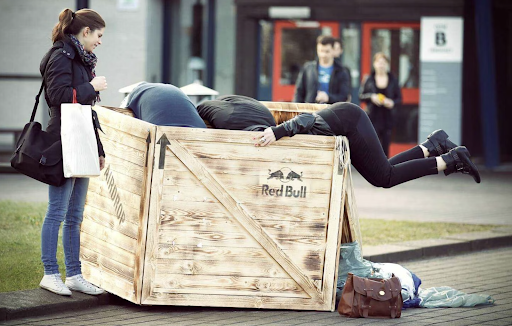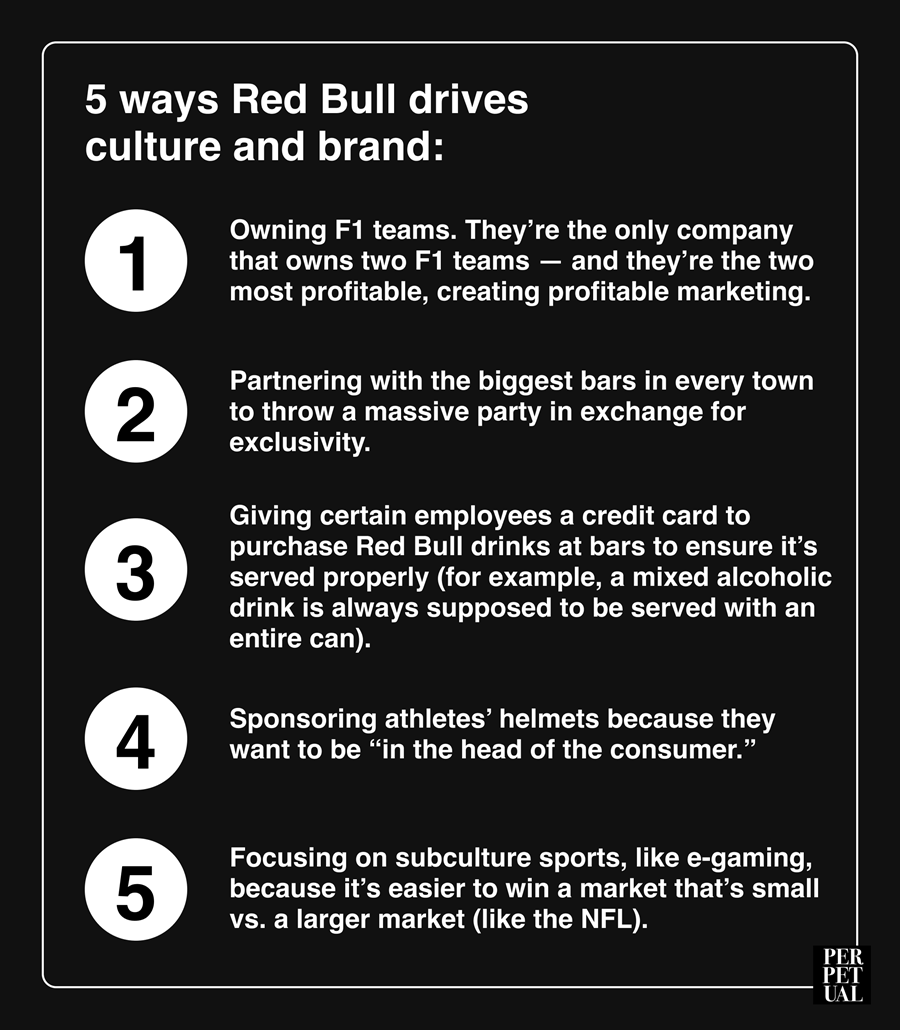20 March 2022 | Media
Brand, “it gives you wings”
By Adam Ryan
8B Red Bull cans were consumed last year.
The privately held energy drink company does more than $7B in annual revenue and has 24% of the market share of energy drinks.
Similar to media companies, consumer packaged goods — like beverages — have no real defensible moat like unique technology or patents do. The barrier to launch a competitor is somewhat small, and copy-paste companies pop up all the time.
That’s why Red Bull is so impressive — they’ve remained at the top of their industry for decades.
Okay, I know some media operators are rolling their eyes right now. You might be asking, “How does a caffeinated gas station drink compare to my newsroom filled with journalists?”
Here’s how: In both industries, brand is the only moat.
The beginning of the brand
The original Red Bull drink was developed in 1976 by Chaleo Voodvidhya, a Thai businessman, and was sold under the name Krating Daeng (Thai for “red bull”).
In 1982, an Austrian entrepreneur, Dietrick Mateschitz, consumed the energy drink and claimed it helped him fight jet lag. For the next 5 years, Mateschitz worked with Red Bull on their recipes and brand strategy. In exchange, he was given 49% of the business and told he was the de facto leader of the company.
It was then that Mateschitz changed Karting Daeng’s name to Red Bull and began to build the brand.
In 1987, Red Bull created their famous logo with two bulls charging each other. The bulls are charging each other because they’re both red, but the logo represents much more than that.
The logo signals Red Bull’s brand values of speed, power, and risk-taking — everything they want their drink to represent for their customers.
In the late 1980s, the brand began sponsoring boxing matches, spreading their logo across boxing ring floors. They wanted to be present where their values were represented and their key customers were present. The clever strategy showed promise. Sales took off in Asia through the late 1980s and early 1990s.
In 1997, Red Bull launched internationally and captured more than 50% of the market share in the US within 18 months.
Innovation through consistency
At the end of the day, both media and CPG businesses are an execution game. To execute, most brands rely on brand pivots and changes — not because they want to, but because they need to in order to stay relevant.
Unlike most brands, Red Bull hasn’t changed much in the last 30+ years:
- Their logo hasn’t changed since 1987
- The values of the brand have never been wavered
- No new products were launched beyond original Red Bull for 21 years
- The core target demographic (working class consumers) has never changed
Instead of constantly adapting their logo or name, like most consumer brands, Red Bull’s brand strategy is to be as creative as possible within their existing brand.
Their secret sauce? Their bold yet open-ended tagline: “It gives you wings.”
The tagline seems so simple, but it’s enabled their brand to adapt to culture without much change. “It gives you wings” is just as suitable for a boxing match or skydiving from space as it is for helping you pull an all-nighter in grad school… or stay up to write a newsletter when your 10-week-old baby has been keeping you up all night.
Most media companies fail to develop an adaptable brand structure.
Most media companies fail because they become irrelevant.
Cultural relevance is the key
Having a great logo, product, and tagline doesn’t mean anything for a brand if you don’t have a pulse on culture.
Red Bull has created systems to keep that pulse pumping.
One of those systems? Their college student ambassador program — it’s one of the most robust in the country. According to their site, they look for entrepreneurial students who are highly connected on campus and outgoing.
As someone who was in that program for two years, it was amazing to see them capitalize on campus culture.
My favorite campaign I ran for them was “Air Drop”: Red Bull shipped me a massive box that looked like it fell out of an airplane and was packed full of Red Bull cans. My job was to:
- Locate the coolest place on campus where students hung out
- Drop the box there at 5am
- Drive interest in the box by texting a ton of people about “a giant box that looked like it fell out of an airplane.”
By 10am the campus was going crazy. It owned the narrative for an entire day and people were posting pictures all over social media.

But my campus wasn’t the only one — Red Bull did this on more than 500 campuses at the same time. All at once, #AirDrop was trending nationally and convenience store sales jumped 130%.
The campaign was a success because Red Bull was able to truly tap into culture: they used students instead of outside marketers to get the right location, the right people, and the right time to make it huge.

You’re receiving access to this content because you referred 1 or more person to Perpetual!
Building your brand
Red Bull built a brand that people not only trusted, but loved sharing and talking about.
Media businesses need to do the same. You can have the best journalists in the world, but if your media isn’t shared and trusted, it doesn’t matter much — a competitor with a better brand will sweep in and crush you.
So, how do you do it?
Know your values
The start of any brand is determining what you stand for, how you will go about accomplishing your mission, and what will make you stand out. This template is what Workweek used to get started and the answers inspired our entire brand.
Invest in development
Don’t be cheap when it comes to developing your brand — hire an agency or a professional to guide you. Workweek forked up about $20,000 for this process before launch and we constantly talk about how it was the best investment we’ve ever made. Having a great brand makes you feel much bigger than you may actually be.
Consider the details
The tiny details of your brand and product is what makes it feel special.. If your attitude is “most people won’t notice”, you’re forgetting that the people who will notice the little things will probably be your top customers.
Stay consistent
As Red Bull has shown, consistency compounds brand value. Whether it’s font choice, logo mark usage, marketing campaigns, or your brand values, hold your team accountable for consistency. The longer you maintain consistency, the bigger the moat you’ll build.
Your brand is only as strong as your weakest appearance
This is one of the life lessons Red Bull taught me. When I was a student ambassador, they told me there could never be any pictures of a Red Bull can that has been crushed on the sides or dropped in a bathroom. Why? Because these moments show your brand at its worst — and your brand is only as strong as its weakest appearance. Thought exercise: think about this with advertisers
It’s not as hard as it sounds
The shortcut to building brand? Cultural relevance.
Cultural relevance is everything from knowing where the cool places are on campus to knowing the most popular memes. It’s intertwining trash TV with B2B essays. Cultural relevance is your team living in the moment, embracing their personalities, and intertwining that with their professional work.
For most industries, being culturally relevant is, at best, simply not in their wheelhouse — at worst, it’s impossible. That’s media’s advantage. Media businesses are inherently culture businesses.
Unfortunately, most media companies don’t embrace this strength — usually out of fear. Fear of saying the wrong thing, getting called out, staying PC. Screw that. It’s time for media companies to embrace cultural relevance.
It’s time for media companies to build brands that resonate.